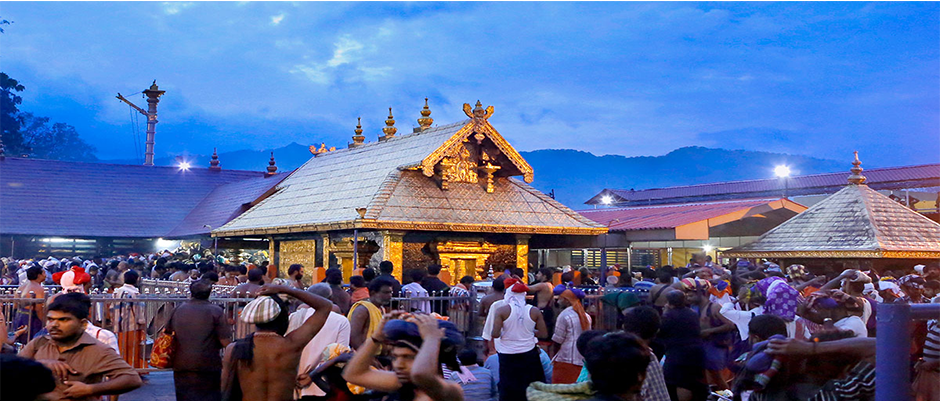
Sabarimala Temple
Sabarimala: The Sacred Journey to Lord Ayyappa
Sabarimala Sree Dharma Sastha Temple, devoted to Lord Ayyappa, is the most renowned among all Sastha temples in Kerala. Located on a hilltop about 3,000 feet above sea level in the Pathanamthitta district, this temple is unique in many ways. It welcomes devotees of all religions, symbolized by the nearby shrine Vavaru Nada, dedicated to Vavar, a close companion of Ayyappa, promoting interfaith harmony.
The temple isn’t open throughout the year—it opens only during specific periods such as Mandalapooja, Makaravilakku, Vishu, and the first day of every Malayalam month. Devotees preparing for the pilgrimage must follow a 41-day period of celibacy and spiritual discipline. They travel through dense forests or opt for a less strenuous route from Pamba to reach the temple.
The Divine Origins of Lord Ayyappa
The story begins with the Pandya dynasty, ousted by Thirumala Naicker, settling in areas like Valliyur, Tenkasi, and Sivagiri. One branch, from Chempazhanattu Kovil in Sivagiri, was granted the right to rule Pandalam. King Rajashekara, from this lineage, was known for his just rule—but he was childless. In prayerful longing, he and his queen worshipped Lord Shiva for a child.
At the same time, the demon Mahishasura received a boon from Lord Brahma that made him nearly invincible. From Kalakatti, both Lord Shiva and Lord Vishnu beheld the powerful scene unfold before them. She too received a boon—only a son born of both Lord Vishnu and Lord Shiva could defeat her. Vishnu, taking the form of Mohini, united with Shiva, resulting in the divine birth of Manikandan.
King Rajashekara discovered the child during a hunting trip near River Pampa, guided by a mysterious sage who instructed him to raise the child. The infant wore a golden chain, hence named Manikandan (one with a golden neck).
Manikandan grew into a brilliant and powerful boy, mastering martial arts and scriptures. Even his guru recognized his divinity. Before leaving the gurukul, Manikandan healed his guru’s mute and blind son but asked for the miracle to be kept secret.
Meanwhile, the Queen gave birth to a son, Raja Rajan. Wanting her own son to succeed the throne, and manipulated by the cunning Diwan, she faked a mysterious illness. The Diwan conspired to send Manikandan to fetch tiger’s milk, hoping he would perish.
Despite his father’s hesitation, Manikandan insisted on going alone into the forest, taking only basic offerings. As he journeyed, he confronted and ultimately defeated Mahishi near the Azhutha River in a fearsome battle. His dance of victory echoed through the heavens, and Mahishi, realizing his divine origin, surrendered.
Lord Shiva and Lord Vishnu observed this intense event from the sacred spot known as Kalakatti. The site also links to Malikapurathu Amma, who attained moksha there.
Following this, Manikandan was guided by Lord Shiva to obtain the tigress’ milk with help from Lord Indra. He returned to Pandalam on a tiger, followed by female devas in tigress forms and male devas as tigers. His arrival stunned the people, and the King, realizing his son’s true nature, was filled with awe and remorse. The Queen’s illness had already vanished—exposing the deception.
Manikandan, now twelve, forgave all and reminded everyone that everything unfolded by divine will. He revealed his purpose was fulfilled and that he must return to the celestial realm. Before departing, he granted the King a boon. Rajasekara wished to build a temple at the spot where Manikandan’s arrow would fall. It landed at Sabari—a place once graced by the hermitess Sabari from the Ramayana.
Guided by sage Agasthya, the King constructed the Sabarimala temple. Lord Ayyappa proclaimed that only those who observe 41 days of strict penance and celibacy would be eligible to receive his blessings. Pilgrims still follow this path—carrying irumudis on their heads, chanting “Swamiye Saranam Ayyappa,” bathing in River Pampa, and climbing the sacred eighteen steps to the temple.
As foretold, Parasurama himself installed the deity on the day of Makarasankranti, cementing Sabarimala’s place as one of India’s most revered pilgrimage destinations. Each year, millions make this spiritual journey—beyond caste and creed—for a glimpse of Dharma Sastha, the divine guardian of righteousness.
Pooja Time (IST)
Morning
Opening of sanctum sanctorum: 3:00 AM
Nirmalyam
Abhishekam
Ganapati Homam: 3:30 AM
Neyyabhishekam: From 3:30 to 7:00 AM
Usha Pooja: From 7:30 AM
Neyyabhishekam: From 8:30 – 11:00 AM
Neyyabhishekam (using Ghee deposited in ‘Ney thoni’): 11:10 AM
Ashtabhishekham (15 nos): From 11:00 to 11:30 AM
Ucha Pooja: 12:30 PM
Closing of sanctum sanctorum: 1:00 PM
Evening
Opening of sanctum sanctorum: 3:00 PM
Deeparadhana: 6:30 PM
Pushpabhishekam: From 7:00 to 9:30 PM
Athazha Pooja: From 9:30 PM
Harivarasanam: 11:00 PM
Closing of sanctum sanctorum
